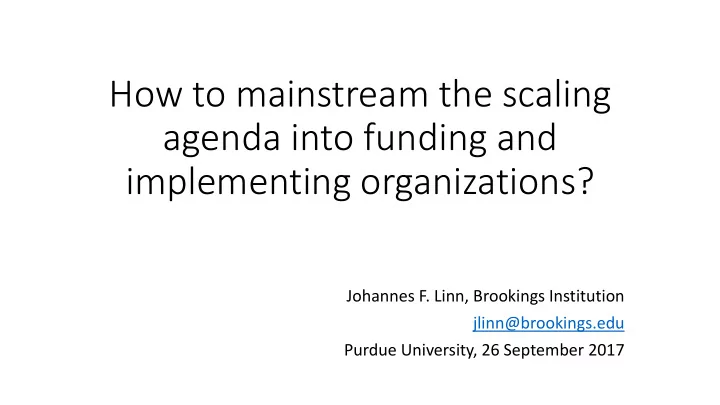

How to mainstream the scaling agenda into funding and implementing organizations? Johannes F. Linn, Brookings Institution jlinn@brookings.edu Purdue University, 26 September 2017
The imperative of institutionalizing the scaling agenda • Organizations are critical for scaling up • Implementing agencies • Funding agencies • The idea and practice of scaling must go beyond a limited number of individual actors and be mainstreamed in the DNA of organizations • This requires a focus on how organizations currently work and what must be done to adapt their organizational approaches to reflect the scaling up agenda 2
Where is the scaling agenda in the organizational practice? Global Innovation Scaling IFAD, Heifer, GF (Global Fund Innovation Labs (USAID, initiatives at Eleanor Crook for HIV/AIDs, etc.), Fund (GIF) DFID, UNDP, World Bank, Foundation, GFF (Global etc.) AfDB, UNDP, Sustainable Financing Facility GIZ, CYMMIT, Harvest for EWEC), etc. Save the International, etc. Children, etc.
Institutional mainstreaming of scaling up is in effect a scaling up process • It takes time and persistence • It requires • a vision • a systematic approach • strengthening enablers (champions, leadership from the top, staff incentives, partnerships, etc.) and reducing barriers (bureaucratic inertia, staff overload with “new fads and buzz words”, the cost of training and staff development, etc.) • appropriate action • monitoring and evaluation of progress 4
How to approach the mainstreaming process • Review/assess current organizational practices • Vision and strategy • Operational business models and instruments • Internal policies, management processes and staff incentives • Guidelines and training • M&E approaches • And align them with the scaling agenda • Regularly monitor and intermittently evaluate the mainstreaming process 5
Some common pitfalls to sustainable mainstreaming • We’re big and already doing it • We’re too small • Don’t tell me what to do – why would you know better? • Yet another fad best ignored • Other fads come along, diverting my attention • Our leadership changes • We don’t have the money • Our front-line is already overloaded • Your methods/operational guidance too generic/complex/burdensome • We can’t keep track of whether the scaling -up approaches are implemented and working as intended 6
IFAD’s effort at mainstreaming scaling up IFAD Scaling-up Initiative 2008-2018 – a long-term effort: 1. Internal evaluation and in-depth study by Brookings (2008-12) • Development of a systematic approach and recommendations for operationalization 2. Scaling- up introduced into IFAD corporate strategy (“Scaling up is mission critical for IFAD.“) (2012) 3. Explicit commitment to scaling up in replenishment consultations (2011 u. 1014) 4. Introduction of scaling principles into operational practice (2012-18) • Guidelines and knowledge products (incl. subsectoral approaches) • Country strategies • Project design, quality assurance and implementation • Country program and project evaluations • Staff training • Networking (lead role in the ARD Working Group der iinternational Scaling Up Community of Practice) 5. Independent evaluation of IFAD‘s scaling up efforts (2017) • Examples of successful scaling up (e.g., India, Peru, Tanzania) • Progress with operational mainstreaming but still not fully integrated in the work of IFAD country teams 6. New senior management considering whether and how best to advance the scaling agenda (2018) 7
Key lessons • Focus on changing the mindsets of managers and staff by showing them that a systematic approach to scaling will help them achieve shared development objectives (e.g., DDGs) more effectively • Develop an approach that responds to specific needs of the institution (drawing on alternatives available and experience to date, with own managers/staff in the lead) • Provide practical guidance and training to staff (and consultants) • Bureaucratic processes need to be kept as simple as possible • Allow more risk taking, recognizing that lack of success in projects is an opportunity to learn, rather than a failure • Link up with clients, partners and funders in pursuing the scaling agenda • Monitor and evaluate • Remember that scaling is about more and better development impact, not necessarily about more money or bigger organizational footprint • Stick with it! 8
Recommend
More recommend